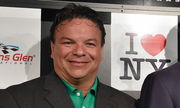
Getty
DAYTONA BEACH, FLORIDA – AUGUST 29: Jimmie Johnson drives the #48 Ally Chevrolet down pit road following an on-track incident during the NASCAR Cup Series Coke Zero Sugar 400 at Daytona International Speedway on August 29, 2020 in Daytona Beach, Florida. (Photo by Chris Graythen/Getty Images)

Getty
DAYTONA BEACH, FLORIDA – AUGUST 29: Jimmie Johnson drives the #48 Ally Chevrolet down pit road following an on-track incident during the NASCAR Cup Series Coke Zero Sugar 400 at Daytona International Speedway on August 29, 2020 in Daytona Beach, Florida. (Photo by Chris Graythen/Getty Images)
Does the term ‘gentleman’ adhere to the medieval notion of being chivalrous or the ones that belonged to families of nobility? Well, there might be a plethora of definitions all across the globe, but it does not apply to the definition that is prevalent in the world of NASCAR. A new fan might be surprised to be apprised that a commonplace term played a pivotal role in the fast track and also in the development of certain rules in the sports’ playbook.
Watch What’s Trending Now!
If one is wondering what is the ‘gentleman rule’ and if it is related to grave-looking men in fitted tuxedos, during official ceremonies of NASCAR, then the answer is assuredly a no. This rule was prevalent in the late 90s and early 20s. However, the authorities had to intervene as it compromised the safety of the drivers, and new rules were implemented. Without further ado, it’s time to delve deeper into this self-policing rule of drivers and why was the unwritten rule scrapped.
ADVERTISEMENT
The implementation of the unwritten rule by the veterans of NASCAR
In the recent past, the paddocks of NASCAR have been rife with drivers complaining of the lack of etiquette among their peers and aggressiveness among each other. Moreover, the debate about lack of etiquette is still ongoing and has hardly shown any signs of simmering down. However, before this debate became a prevalent topic for discussion in NASCAR, it was the ‘Gentleman’s Rule’ that received the limelight, from the drivers and the authorities alike.
The ‘Gentleman’s Rule’ or agreement did not require the drivers to stamp their signatures on an agreement or make a pinky promise, but was solely based on mutual trust among the drivers. These promises don’t skirt the rules but strengthen the respect among peers. This unwritten rule came into play in the 1970s, when the sport was yet to be technologically strengthened. Moreover, the position of a car on the track was in relation to other cars and was maintained by human scorers who kept an eye on the cars when they crossed the start-finish line.
Following this, whenever the yellow flag was waved as a sign of caution owing to a wreck or other problems, the drivers were marked on the note when they crossed the start-finish line next. This designated that the drivers would have to continue to race back to the line in their own best interest, even though an impaired car was present on the track. However, this raised questions about the safety of the drivers and amplified the chances of another crash on the track.
ADVERTISEMENT
Watch this Story: Kyle Busch brings in another sponsor for Richard Childress Racing
This ‘racing back to the line’ was crucial for the lapped cars, who could race back to the line and earn a decent finish in the race. Nevertheless, owing to the inherent danger that loomed in the ‘racing back to the line’ strategy, celebrated drivers conjured up with a mutual solution, the ‘gentleman’s agreement.’ Veteran drivers like Richard Petty and Cale Yarborough came up with the solution of slowing down and holding onto their positions whenever a caution was issued on the track. Moreover, it was decided to accommodate a single-lapped car to gain back its position under the yellow.
ADVERTISEMENT
Speaking about this agreement in a 2003 interview, the then NASCAR President Mike Helton stated, “They all went off on their own and made an agreement: When the caution comes out, let’s throw up our hand, and everybody should whoa up at the same time. That’s the gentleman’s agreement. It’s been working pretty well up until recent years.”
Top Stories
Greg Biffle’s $4M Worth Prized Possession Still Without a Buyer Leaves NASCAR Fans Heartbroken

Denny Hamlin Offers First Words Since Losing Beloved Father in Anniversary Fire

Fox Broadcaster Pens Heartfelt Message as Veteran Announcer Quits NASCAR

NASCAR World Mourns as Former Watkins Glen President Michael Printup Passes Away at 60

“This Is Not Racing”: Growing Outrage Erupts Over How Kids Are Being Taught to Win at Any Cost in Modern Motorsports

NASCAR implements new rule axing down the ‘Gentleman’s Rule’
However, the scenarios changed after 30 years in 2003, during the race at Sonoma, when Robby Gordon passed Kevin Harvick under the yellow and took the chequered. A similar incident occurred a few races later when Jimmie Johnson surpassed Michael Waltrip. While these incidents compelled the authorities to intervene, the final nail in the coffin was Dale Jarret’s crash in New Hampshire, which led NASCAR to revise this rule.
ADVERTISEMENT
The lapped cars, instead of slowing and driven by the hopes of winning back their lost laps, rushed past the damaged car of Jarret. This action by the drivers increased the probability of compromising the safety of the drivers.
ADVERTISEMENT
Speaking on the fateful situation, the veteran expressed to the media, “My spotter told be to stay buckled in because (the rest of the field) was coming. I started to get unbuckled, but then as he reminded me of that, I buckled back up.” Following this, NASCAR issued the rule of ‘freezing the track’ if a caution was issued. However, this rule made it nearly impossible for the lapped cars to regain their position.
This paved the way for the implementation of what came to be known as the ‘Lucky Dog Rule’, which allowed a lapped car with the highest track position to regain its position if a caution was issued.
ADVERTISEMENT
Although the ‘Gentleman’s Rule’ was widely celebrated in the garage area of NASCAR, it came with its own set of disadvantages. It had the potency to jeopardize the safety of the drivers, as well as delay the immediate assistance needed on track. Nonetheless, this rule has evolved to accommodate the demands of changing times.
ADVERTISEMENT
ADVERTISEMENT
ADVERTISEMENT

